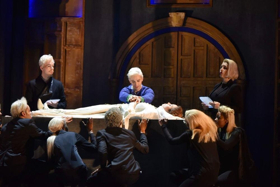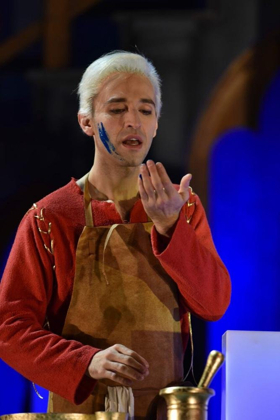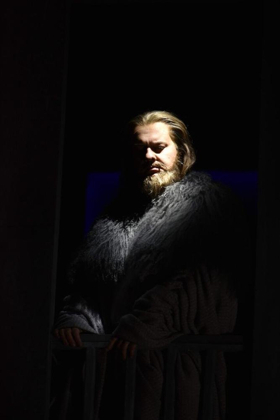Review: No Heart on the Sleeve of WRITTEN ON SKIN at Opera Philadelphia

Photo: Kelly & Massa for Opera Philadelphia
Opera Philadelphia's production of the George Benjamin-Martin Crimp WRITTEN ON SKIN is another feather in the cap of the company that's quickly becoming the one to watch in the world of contemporary opera.
After providing three world premieres at its O17 Festival last fall, this time the company is "merely" providing a local debut, in a new production, for a contemporary piece--although one that's been hailed as a masterwork since its world premiere at the Aix-en-Provence Festival in 2012 (where it was preserved on DVD). Is the opera that good?

Kelly & Massa for Opera Philadelphia
Time will be the ultimate judge, but on first viewing, at Philadelphia's Academy of Music this past Sunday, I can say for sure that the 95-minute work is mesmerizing and fascinating. Benjamin's score, except for an opening scene where the angels set up the action to take place, manages to be challenging while falling gracefully on the ear--no easy trick. This may be his first full-length opera, but there is nothing tentative in his work.
Benjamin and Crimp have collaborated seamlessly: One's work simply could not exist without the other's. Conductor Corrado Rovaris led the Opera Philadelphia orchestra in a thoughtful reading of the piece that must have been a challenge with a score this demanding.
It is impressive that SKIN succeeds despite idiosyncrasies that could be seen as off-putting: It's told in the third person--with character referring to themselves by their role names, eg, the Protector, the Boy, the Woman. Somehow, it works well here, a salute to the performances as well as the creators. And while I have some questions about aspects of it, this production by William Kerley, sets and costumes by Tom Rogers, preserves the greatness of the piece.

Kelly & Massa for Opera Philadelphia
As they say in the movies, SKIN is "based on real events." In this case, it's the life of a 12th century troubadour, though the creators had the good sense to change the thrust of the story from music to art, adding in elements of betrayal, murder, suicide and, well, much more. Crimp's pithy, smart libretto is based on an anonymous 13th century razo (a short piece of prose from southwest France) about the troubadour, Guillem de Cabestanh, called Le coeur mange, which translates as "the eaten heart" (which is appropriate to the denouement of the work)
Using a framework of modern angels who take us back to a time some 800 years in the past ("fade out the living, snap back the dead to life"), the story tells of a wealthy landowner, called the Protector, who brings in an artist, the Boy, to create an illuminated manuscript glorifying the life of his family ("show us in our rightful place: show us in paradise"). It was a time when such a manuscript was "written on skin"--on the hide of animals. Among the man's property is a wife (the Woman/Agnes), a child, one first assumes: She's 14-years-old and can neither read or write. It's not long, however, before she proves she's a woman in a seduction of the Boy that ends in tragedy, since she is determined to rub the affair in her husband's face.

Kelly & Massa for Opera Philadelphia
Rogers's set works wonderfully with the quickly shifting landscape, with the important aid of Howard Hudson's lighting design. It's a kind of rotating Chinese box, opening each side to see the treasures within (I particularly liked the gold and deep blue motif when the Protector comes to confront the Boy about the affair). His costume designs added to the total effect without shouting out their name.
Having seen the DVD of the production in Aix, it's hard to separate those originators from the roles and the balance of the players works differently here. The heaviest lifting certainly goes to soprano Lauren Snouffer as the Woman/Agnes, who must go from naïve and put upon to hellion in a very short space of time. Her fine-tuned portrayal and piercing sound made one sit up and take notice. Countertenor Anthony Roth Costanzo brought his ethereal sound and flexible voice to roles of the Boy and First Angel and fits the role's parameters--thought perhaps too boyish to be a match for the Woman. As the Protector, baritone Mark Stone sang powerfully and was properly brutish but I missed a touch of madness in his portrayal.
The cast was rounded out very well by mezzo Krisztina Szabo as the Second Angel and the Woman's sister, Marie, and tenor Alasdair Kent as the Third Angel and Marie's husband, John.
The old saw says that the U.S. and England are two countries separated by a common language. (Ah, for that simpler time!) In the world of music, it often seems that the gulf is even greater. That's not the case with the fine musical vocabulary of WRITTEN ON SKIN. I can't wait to see what else Benjamin and Crimp have up their sleeve, with LESSONS IN LOVE AND VIOLENCE, premiering at Covent Garden in May.
Reader Reviews
Videos

